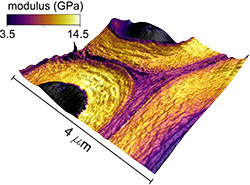Donna Hurley, National Institute of Standards & Technology
Roger Proksch, Asylum Research, an Oxford Instruments Company
 Nanoscale information on mechanical properties is critical for many advanced materials and nanotechnology applications. Atomic Force Microscopy techniques for probing mechanical properties of samples in the nanometer range have emerged over the past decades. In contrast to the large number of techniques for softer samples, few techniques are capable of measuring moduli in the 1-200 GPa range. One technique, Contact Resonance (CR), has proven to work very well in this range. CR methods operate in contact mode with dynamic excitation near a cantilever resonant frequency, enabling sensitive measurements over a wide range of materials. Moreover, analysis of the CR peak frequency and quality factor yields accurate, quantitative data on elastic modulus and viscoelastic damping.
Nanoscale information on mechanical properties is critical for many advanced materials and nanotechnology applications. Atomic Force Microscopy techniques for probing mechanical properties of samples in the nanometer range have emerged over the past decades. In contrast to the large number of techniques for softer samples, few techniques are capable of measuring moduli in the 1-200 GPa range. One technique, Contact Resonance (CR), has proven to work very well in this range. CR methods operate in contact mode with dynamic excitation near a cantilever resonant frequency, enabling sensitive measurements over a wide range of materials. Moreover, analysis of the CR peak frequency and quality factor yields accurate, quantitative data on elastic modulus and viscoelastic damping.
In this webinar, we’ll explain the basic concepts of measurements with different CR approaches including:
• Point spectroscopy
• Qualitative contrast imaging
• Quantitative mapping
We’ll also discuss practical implementation of contact resonance to a variety of samples and some of the pitfalls and artifacts you might encounter. Finally, we’ll present results on how CR methods have been used to improve understanding of systems such as:
• Composites
• Thin films
• Biomaterials
• Polymer blends
The nanomechanical characterization capabilities of CR methods, as you will come to learn, are an essential tool for the development, production, and in-situ monitoring of today’s and tomorrow’s materials.
Click here to register

